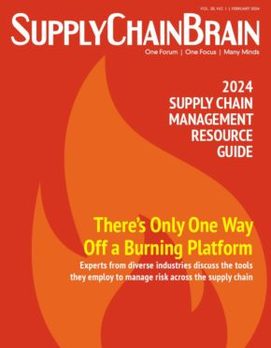
Home » IBM, Solectron Seek Greener Pastures for Product Recycling
IBM, Solectron Seek Greener Pastures for Product Recycling

It's common knowledge that most computers, cell phones, video games and other high-tech gadgets aren't actually made by the companies whose names are on the products. The role of behind-the-scenes contract manufacturers has been well-established for decades. Now, the same type of arrangement has found its way to the very end of the supply chain: the process of disposal, reuse and recycling.
Once again, the pioneer is a familiar name in high-tech: IBM Corp. It was one of the first to turn over the basic manufacturing of personal computers to independent partners. Among the earliest beneficiaries of that strategy was Milpitas, Calif.-based Solectron Corp. So it's no surprise that the long-time partners have united once more to offer a joint service, with IBM's name on the door and Solectron holding the keys.
The relationship between IBM and Solectron goes back to the latter's very inception in 1977. But the idea to collaborate on the reverse supply chain didn't start percolating until some time later. IBM began doing asset recovery in support of its equipment-leasing subsidiary in the mid-1980s, according to Linda Demmler, director of worldwide global asset recovery services and sales. It continued with what was essentially a localized service into the 1990s.
At that point, IBM began widening its scope, with the branding of its Global Asset Recovery Services venture. Operating within the company's Global Financing unit, GARS was looking to take back product, not just from IBM and its leasing customers, but anyone who wanted safely to dispose of old or obsolete equipment, which otherwise would clog up the world's landfills.
IBM happened to be engaged in an ongoing reappraisal of operations across the board, with an eye toward shedding any non-core processes that could potentially be done more efficiently by trusted outsiders. And efficiency was the byword: GARS was turning into a massive operation, one that held substantial promise from the standpoints of profitability and environmental responsibility, but could get out of hand if not properly managed. Following its own lead in front-end manufacturing, IBM decided to move from a fixed to variable-cost model in the reverse supply chain. Once again, Solectron was hired.
Demmler calls the engagement "a natural extension" of the partnership between the two companies. For its part, Solectron was already eyeing the aftermarket business. Debuting in mid-1999, Solectron Global Services soon approached IBM about managing the latter's campus in Raleigh, N.C., says Steve Manning, senior vice president of marketing and business development with SGS.
The partners didn't start small. In early 2000, Solectron took over the GARS operations in Raleigh. The initial three-year agreement called for the vendor to assume all responsibilities for the processing of incoming equipment, and determination of its fate. The IBM center became a fully-integrated part of SGS, with some 450 IBM employees in the Raleigh multi-ship operation shifting over to the Solectron payroll.
Solectron also performs asset-recovery services for IBM at its headquarters in Milpitas, as well as locations in Amsterdam, Memphis and Toronto. The company has taken on a wide range of tasks, including product repair, maintenance, upgrades, re-manufacturing, call-center support, parts management, disposal and handling of hazardous materials. Products serviced at the Raleigh location include personal computers, laptops, monitors, servers, printers, storage products and point-of-sale equipment.
Solectron moved quickly to achieve IBM's goal of squeezing more efficiency out of Raleigh. It slashed the physical size of the operation by a third, combining two buildings into one 285,000 square-foot facility. The remaining warehouse was redesigned with narrower aisles, and procedures were implemented to reduce travel time by workers. Solectron applied kaizen techniques, borrowed from Japanese production theory, whereby employees continuously strive to eliminate waste. The Solectron Production System also tosses into the mix Lean operating principles and Six Sigma quality monitoring. One example of an improvement that arose from the effort was creation of a flexible workstation design, which helped the company to adjust to changes in volume flowing through the center.
The process begins before product arrives at the GARS facility, says Manning. IBM knows what it has on lease and when each contract is set to terminate. With that information in hand, and following electronic notification by IBM, Solectron contacts the lessee and arranges to begin the process of dismantling, packaging and shipment to Raleigh. The company will already be in possession of all serial numbers and information on current product configuration.
Where's It Going?
The ultimate disposition of the equipment is also determined in advance. Demmler says IBM has its own criteria for making that decision, but it's based in large part on audit, verification and test (AVT) procedures performed by Solectron. "If we think we can resell in the marketplace," she says, "it's critical that AVT processes are executed thoroughly and in a timely manner, so that we can get product to market as quickly as possible."
"You don't want equipment sitting on the back dock, waiting to get cross-docked," adds Manning. So Solectron moves quickly to close out the lease, verify the assets that are received, and take action depending on whether there is immediate demand for the returned product. Some items might be tested and set aside to fill later demand, he says.
Solectron's complete menu of responsibilities includes the logistics of moving items into the recovery center, running the warehouse, conducting repairs, separating out hazardous materials and precious metals, arranging for liquidation or scrapping, shipping out refurbished items, tracking orders and supporting systems installation. Specific tasks might include erasing hard drives, restoring product to "like-new" condition, and reloading operating systems before equipment goes back out of the facility.
Under a broader agreement with IBM, Solectron also took on repair services for the ThinkPad laptop (now made by Lenovo, the Chinese-based company that purchased IBM's PC line in 2005). Solectron promised a 36-hour, door-to-door repair service, while keeping tabs on global suppliers in order to ensure the continuous availability of parts.
Many components from old or defective items can be incorporated into refurbished equipment. Especially crucial is the safe removal or disposal of hazardous materials. Cathode ray tubes (CRTs), for example, are carefully ground or melted down. The action must be accompanied by "a very clear audit trail" for regulatory authorities, says Manning. All types of hazardous items must be segregated and kept out of landfills.
Other companies are just beginning to catch up with IBM on the handling of hazardous components inside high-tech equipment. They are motivated by more than social responsibility. New laws being implemented around the world require manufacturers to safely dispose of such materials, and in many cases remove them from products altogether. The European Union's passage of the Restriction of Hazardous Substances (RoHS) and Waste From Electrical and Electronic Equipment (WEEE) regimes mandated the elimination of several key ingredients within electronic products, including lead, mercury, chromium and cadmium. China has followed up with its own version of RoHS.
Such laws won't eliminate the need for recycling and recovery operations such as that performed by Solectron on behalf of IBM. But Manning says IBM is already well ahead of the curve in the management of hazardous materials. "If the world was full of companies like IBM, they would never have had to process any of these laws," he says. In fact, Solectron sits on some of the European Commission committees that crafted the legislation. Together, Solectron and IBM take great pains to ensure the traceability of such substances, closely monitoring their destruction or disposal.
Worldwide, says Demmler, GARS takes back about 40,000 units per week, submitting all items to the AVT testing procedure before determining their ultimate fate. Less than 1 percent of the materials moving through the program ends up in landfill - and none of that is hazardous.
On the logistics side, Solectron draws on its own network of inbound and outbound carriers to keep inventory flowing. Receiving demand signals from IBM, the vendor will either arrange for transportation or allow customers to pick up product at the site. Solectron also relies on the considerable leverage exerted by IBM over its own carrier base, in a search for the best rates.
With Solectron's help, the GARS operation in Raleigh has become even more efficient. Overall costs have been reduced by 30 percent since Solectron took over. The one-third reduction of square footage, along with the construction of narrower aisles within the warehouse, have reduced travel time by 50 percent. At the same time, Solectron has helped to slash remanufacturing costs for PC refurbishments from $1 to 59 cents, reduce facility costs by 25 percent, increase production by 25 percent, and save some $4m in logistics expense, largely by bringing certain services in-house.
Solectron has streamlined IBM's information systems by installing an enterprise resource planning system in Toronto similar to that of Raleigh's, for the smooth movement of data between locations. In addition, it has implemented common processes at its operations in Canada, Australia and South America.
Supplementing IBM's U.S.-based recovery services is the facility in Milpitas. Manning estimates that 25 percent of IBM's installed base is located west of Denver. "You don't want to be moving equipment a long ways," he says. "You're trying to get the last economic value out of an asset. And you don't want to add a lot of freight cost in the process."
GARS Keeps Growing
In the years since Solectron took over the Raleigh operation, GARS has grown steadily, both in size and stature within the worldwide IBM organization. In 2005, it was awarded the Chairman's Environmental Award, competing with IBM's systems and technology, research, software, services and supply chain units.
In presenting the award, IBM chairman Samuel J. Palmisano cited the function's successful expansion into some 21 countries. He pointed to such innovations as an online private trading exchange, showcasing parts available from GARS to IBM business partners, brokers and other buyers. And he praised GARS's tools for safe disassembly and recycling products in an environmentally responsible manner.
Even with Solectron doing the heavy lifting, GARS maintains close ties to other units of IBM, including Brands, Integrated Technology, and the fabled Integrated Supply Chain - the last of which has taken billions of dollars of cost out of the organization over the past five years. ISC and GARS share the common goal of creating an "on-demand" company, making generous use of outsourcing wherever it is deemed practical.
Working with those other corporate functions, GARS reused the equivalent of 5.3 million parts between 2002 and the receipt of the chairman's award in 2005. More than 1.88 million end-of-life machines were reused between 2003 and 2005. One beneficiary of the program was the company's 728 zSeries mainframes, many of which were built from the components of used machines beginning in 2002.
GARS helped IBM to achieve the distinction of recovering and recycling more equipment than any other information technology business, the company claims. In 2005, IBM became the first IT company to exceed 1 billion pounds of recovered product waste. (The actual total for that year was 1.3 billion pounds.)
More recent statistics suggest that activity continues to grow at Raleigh. Over the past three years, Solectron says, IBM's asset-recovery and disposition program has taken in and reused more than 1.9 million machines, and generated $5.1bn in revenues. In 2006 alone, the program processed more than 108 million pounds of end-of-life products and associated waste. The estimated $93m in assets that were removed by customers around the world last year represented a 10.5-percent increase over 2005, IBM says.
GARS is just one part of a larger commitment by IBM to "green" initiatives. As far back as 1990, company executives were voicing concern over issues such as global warming, the depleting ozone layer and high-tech equipment disposal. Shortly after that, IBM came up with a program for assessing the environmental impact of its products. A goal of recycling 50 percent of all wood, metal, paper, glass and plastic from manufacturing plants was already in place by 1988, according to John Davies, vice president of green technology research for Boston-based AMR Research. That effort set the stage for similar initiatives within the reverse supply chain.
The first IBM product take-back program, and the earliest manifestation of GARS, was launched in Europe in 1989, Davies says. Last year, the Global Financing unit sold more than $1.6bn in refurbished equipment.
Look for GARS to continue to grow. "This is going to become a bigger and bigger issue, as legislation drives behavior in the U.S.," says Manning. Customers, too, are waking up to the need for more responsible recycling programs, adds Demmler. "The last thing they want is to wake up in the morning and see their name on the front page of The Wall Street Journal for improper disposal."
The National Safety Council has estimated that roughly one billion computers will be retired between now and 2010. In addition, according to the consultancy IDC, there are approximately 150 million obsolete PCs sitting in closets, storerooms and elsewhere. Yet 55 percent of companies don't have their own programs for disposing of used equipment - a situation that cries out for services such as that provided by IBM and Solectron.
"We've just touched the tip of the iceberg on the awareness of customers, and their responsibility for getting rid of those assets," says Demmler. "A partner like Solectron is very important to our strategic success."
To access this article online, visit The Digital Edition at www.SupplyChainBrain.com.
Resource Links
AMR Research, www.amrresearch.com
IBM Global Financing, www-03.ibm.com/financing/us/
Solectron, www.solectron.com
SIDEBAR:
IBM and Solectron: History of a Partnership
IBM and Solectron Corp. have a long history of collaborating on various aspects of the supply chain, with an emphasis on outsourcing key services in both directions. Here are some highlights of their relationship:
- 1992: Solectron purchases an IBM circuit-board assembly plant in North Carolina. Employment at the facility nearly doubles within a year.
- 1998: Solectron buys an IBM electronic card assembly and test operation in Charlotte, N.C. The initial three-year deal involves three manufacturing plants, totaling 42,500 square feet, and calls for Solectron to manufacture printed circuit boards for IBM.
- 1999: Solectron acquires IBM's electronic card assembly and test assets in Austin. As with the Charlotte deal, Solectron will provide design, prototyping, new-product launch, production, and end-of-life support, among other services.
- 2000: IBM and Solectron extend their relationship with a 10-year, $1.8bn IT services contract. IBM will provide consulting and other services to Solectron, in addition to helping the company upgrade its information networks.
- 2000: Solectron acquires IBM's European repair center in Amsterdam, taking over a 93,000-square-foot facility that will soon grow to 161,500 square feet.
- 2006: IBM signs a deal with Solectron to provide indirect procurement services. Drawing on its own substantial economies of scale, IBM will manage more than $1.2bn of annual indirect corporate spend on behalf of Solectron.
RELATED CONTENT
RELATED VIDEOS
Subscribe to our Daily Newsletter!
Timely, incisive articles delivered directly to your inbox.
Popular Stories
-

-

Diversifying Production From China: Welcome to ‘The Great Reallocation’
-

U.S. Fleet Professionals Look Toward Sustainability to Cut Down on Rising Operating Costs
-

Next-Generation Packaging Brings Reliability and Visibility to Supply Chains
-

E-Commerce Boom: Easing Supply Chain Pressure with Omnichannel Supply Chains

2024 Supply Chain Management Resource Guide: There's Only One Way Off a Burning Platform
VIEW THE LATEST ISSUECase Studies
-
Recycled Tagging Fasteners: Small Changes Make a Big Impact
-

Enhancing High-Value Electronics Shipment Security with Tive's Real-Time Tracking
-

Moving Robots Site-to-Site
-
JLL Finds Perfect Warehouse Location, Leading to $15M Grant for Startup
-
Robots Speed Fulfillment to Help Apparel Company Scale for Growth